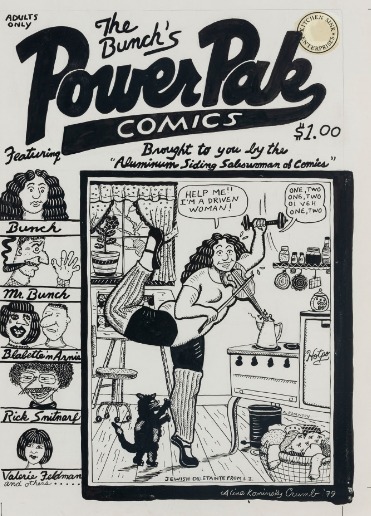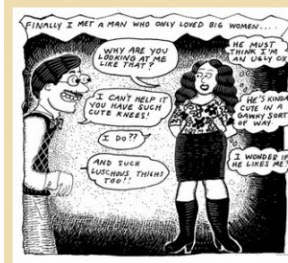 |
| 1948-2022 |
Whenever I do posts about notable people, I usually ignore the various name changes they may have gone through and stick with the moniker that was in place when they first achieved that notoriety. However, it might be a bit misleading in the case of alternative cartoonist Aline Kominsky-Crumb. She grew up Aline Goldsmith on Long Island, met some guy with the last name Kominsky and married him. The marriage didn't last very long, but she must have liked the new surname, as she hung on to it, and continued to hang onto it, albeit in hyphenated form, even after marrying a second time (more, a lot more, about that marriage in a bit.) Whatever she chose to call herself, she was attending the University of Arizona around 1970 or so when she met two cartoonists at a party. Now these weren't the kind of cartoonists that worked for Disney or Hanna-Barbera, nor the kind of cartoonists that drew for DC or Marvel, nor the kind of cartoonists who might have had a comic strip alongside Beetle Bailey and Mary Worth in a daily newspaper. No, Kim Deitch and Spain Rodriguez were underground cartoonists, and the best place to view their work was at some head shop in the bohemian section of town. Deitch and Rodriguez convinced aspiring artist Aline to move to a place that was rapidly becoming the bohemian capitol of America: San Francisco. Aline took their advice, and once settled in the City by the Bay, did what any self-respecting underground cartoonist does, she pushed the envelope:
Actually, she seems to have pushed more than the envelope.
Aline spent the next 50 years producing underground, soon-to-be called alternative, comics (or comix.) The following sampling may not be in chronological order, as I didn't really have the time to track down the dates for a lot of these, but it doesn't matter. Her drawing style, and her forthrightness, changed very little over the decades:
Now, about where that Crumb part of her name came from. If you know anything comix than you'll have figured out it has something to do with...
...this guy, Robert Crumb, sometimes known as R. Crumb, probably the most well-known underground artist to come out of the 1960s (trivia note: he lived for a while in my hometown of Cleveland where he worked for American Greetings.) Aline and Robert met at a party, fell in love, lived together for a few years before eventually marrying in 1978. This union was a bit hard for some of her female underground cartoonist colleagues to take (one of those cartoonists, Trina Robbins, called Alina a "camp follower".) So exactly what was the problem? Robert Crumb's view of male-female relations...
Ain't love grand?





.jpg)


























Hi, Kirk!
ReplyDeleteThe Reaper is working OT and so are you lately, good buddy. Shirley, he has met or exceeded his quota for the year by now!
Sheltered, safe and secure in the serenity of suburbia, shunning sin and steeped in the sanitary, vanilla world of Disney, Hanna-Barbera and Looney Tunes, with Mad and Playboy cartoonists secretly added for spice, and as the kind of person who did not typically frequent the bohemian district, head shops, etc. (my mommy forbade me to perspire until I was 35, and forbade me to spell comics "comix"), I am completely in the dark about the realm of underground, alternative cartoonists and the SF scene in which they flourished. (Wow, now there's a quotable opening line.) However, you should be happy to know that I have finished watching, at your urging, the adventures of Mary Ann Singleton at 28 Barbary Lane in Tales of the City (1993 miniseries) and in Tales of the City (2019 miniseries).
I thank you for the opportunity to learn about this alternative branch of art, this discipline, this means of expression, and about one of its leading figures, in this tribute to comic artist Aline Kominsky-Crumb. I see that you are backed-up and stacked-up with time sensitive tributes, because Aline died of cancer November 29 at the too young age of 74. It was fascinating to scroll down and gaze at these examples of her solo output along with her collabs as a cartooning couple with husband Robert Crumb. Thanks too for introducing their daughter Sophie, a gifted cartoonist in her own right.
Thanks again for remembering edgy underground comic artist Aline Kominsky-Crumb and for displaying so many of her largely autobiographical and confessional cartoons produced through the years. Have a wonderful week, good buddy Kirk!
Mary Ann Singleton really should hook up with an underground cartoonist. Armistead, if you're reading this, hint, hint.
DeleteShady, funny you should mention Mad. And Playboy. And Disney. We'll start with Mad. The 1950s comic book version of Mad had a profound influence on all those underground cartoonists of the 1960s, most of whom grew up in the 1950s. Mad's founding editor, writer and occasional artist Harvey Kurtzman has even been described as the "first" or "original" underground cartoonist, though he never characterized himself that way. Robert Crumb was enamored with Kurtzman's Mad, as well as his later Humbug, and when he was able to do so, made a point of meeting Kurtzman and even worked for him for a while on another magazine, Help (which also employed two people at the beginning of their careers, Gloria Steinem and Terry Gilliam.)
Playboy. Though he grew up in the 1940s rather than the '50s, a former cartoonist by the name of Hugh Hefner was also a fan of Mad, and lured Kurtzman away from publisher William M. Gaines. This resulted in a satirical magazine titled--you're not going to believe this--Trump. Because of a bank loan to Hefner that fell through, Trump lasted only two issues. Hefner, however, wasn't through with Kurtzman, eventually hiring him and former Mad artist Will Elder (another profound influence of the underground cartoonists) on to Playboy itself, where the duo created, wrote, and illustrated the long-running Little Annie Fanny. Once firmly ensconced at Playboy, Kurtzman tried to get former employee Crumb a job there too and got him into the Chicago mansion (which Crumb once compared to a Holiday Inn) to meet Hefner. According to Crumb's version of events, Hefner was out playing backgammon and couldn't meet with him, so instead he talked to Playboy's longtime cartoon editor Michelle Urry, who offered him something like five hundred dollars a page as long as he followed orders (Hefner was a notorious micromanager when it came to cartoonists.) Crumb said no, and it was just as well. Crumb and Hefner may have both liked sexy, naked women, but their was views on what constituted sexy, cartoonwise, were waaaaaaaaaaay different.
Disney. Along with Mad, the heavily plotted Donald Duck comics books of the 1950s also exerted a strong influence on Crumb and other underground cartoonists. Though he toiled in obscurity--Disney comic books had no credits other than Walt's ubiquitous signature--and didn't became publicly known until after he retired, artist and writer Carl Barks was the brains behind these. I have a kind of as-told-to autobiography of Crumb that has a picture of Barks laughing at one the latter's comics.
So, as you can see, Shady, alternative artistic movements don't just spring out of nowhere, and quite frequently are inspired by the very mainstream they seem to be rebelling against. Everybody stands on everybody else's shoulders, even underground cartoonists.
Thanks for the insightful follow-up, Kirk. I learn more here than anyplace else. I realize that your time is precious, and yet you take time to write an in depth response that promotes understanding of the topic. You are a complete blogger, one of the few I have encountered in 14+ years.
DeleteWhy, thank you, Shady.
DeleteI think I may have seen one or two of her cartoons but I don't remember her. She was certainly quite challenging to your society as a good cartoonist can be, and a rather interesting person.
ReplyDeleteUnfortunately, Andrew, there's sometimes a price to paid for challenging society, in that it can land you in an "underground."
DeleteFortunately for Aline, toward the end of her life it also landed her in museums. Over time, society develops a stronger stomach over what it can be challenged at.
I was never a big Robert Crumb fan and didn't know Aline's work at all. But I concede they deserve the moniker of "world's number one cartooning family." In the 90s I was a big fan of many underground cartoonists, mainly gay, lesbian and feminist ones.
ReplyDeleteWell, Debra, I've already done posts on Howard Cruse and Ellen Forney. I hope to someday do posts on Allison Bechdel, Eric Orner, Robert Kirby, Paige Braddock (a former employee of Charles M. Schulz, incidentally), Marc Andreyko, Ariel Schrag, Julia Kaye (who's transgender) and others.
DeleteI'm not at all up on underground comix artists nor even a fan (except for some gay and lesbian ones), so can’t believe I’m familiar with them both.
ReplyDeleteSo, if I'm reading your comment right, Mitchell, you ARE familiar with, much to your surprise. Well, at least that's something.
DeleteMitchell, my reply to you makes no grammatical sense. I meant say:
DeleteSo, if I'm reading your comment right, Mitchell, you ARE familiar with the Mr. and Mrs. Crumb, much to your surprise. Well, at least that's something.
I meant TO say.
ReplyDeleteI don't know her Kirk. RIP.
ReplyDeleteShe was more noteworthy than famous, Ananka, as can best be expected of someone who's "alternative".
Delete